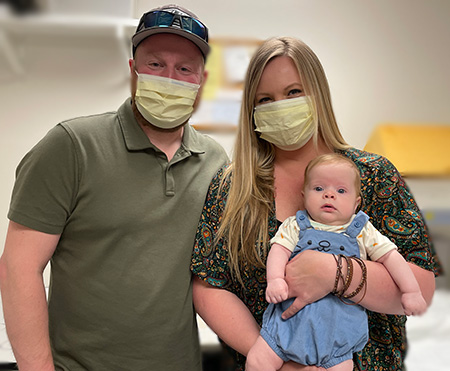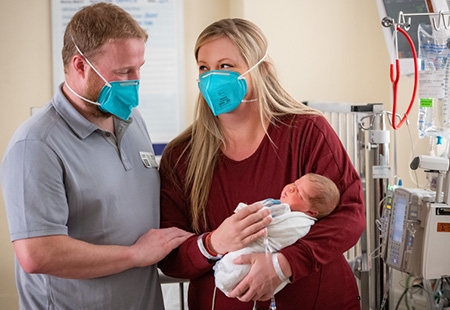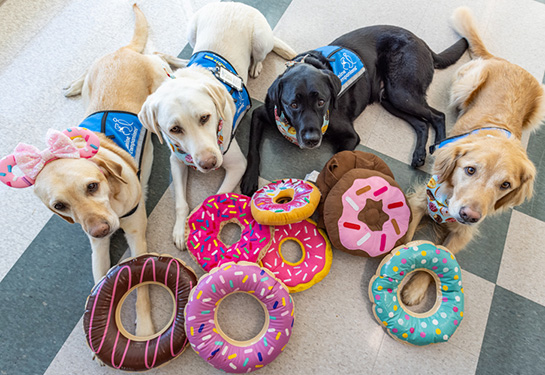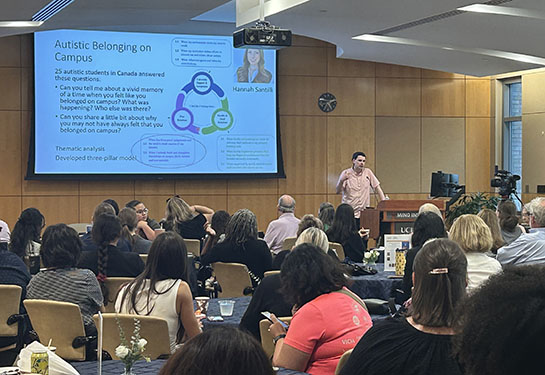CuRe trial gives hope to new mom
World’s first stem cell clinical trial for spina bifida is underway
Read the follow-up story about Tobi.
At Michelle Johnson’s 20-week ultrasound, she received the distressing news that her developing baby was diagnosed with myelomeningocele, also known as spina bifida.
Spina bifida occurs when spinal tissue fails to fuse properly during the early stages of pregnancy, leading to a range of lifelong cognitive, mobility, urinary and bowel disabilities. It affects 1,500 to 2,000 children in the U.S. every year.
This pregnancy was Johnson’s first with her partner Jeff Maginnis. Johnson has a 12-year-old son, Corbin. Maginnis has a 5-year-old daughter, Cameron. The couple, who live in Oregon, were excited to build their new family together.

Suddenly, they were forced to think about wheelchairs and crutches and getting ramps installed into their home.
“We had no clue of what the fate of that diagnosis would mean for our child,” Johnson said. “But we did know that no matter what happened, we loved this baby and we would do whatever it took to give our baby the best outcome.”
Fetal surgery would be needed to repair the neural tube defect. Johnson’s fetal surgery referral was in process, when she heard about the world’s first FDA-approved human clinical trial using stem cells before birth to treat spina bifida at UC Davis Health. The clinical trial, known formally as the “CuRe Trial: Cellular Therapy for In Utero Repair of Myelomeningocele,” is funded by the state’s stem cell agency, California Institute for Regenerative Medicine (CIRM).
Johnson applied to participate in the UC Davis clinical trial, knowing that she and Maginnis would need to move to Sacramento for the rest of her pregnancy, if she was accepted. It would mean months of being away from their children, family and friends, her job and the comforts of home.
“I thought of the sacrifice that would go into it and knew that the sacrifice would be worth it to get the best treatment in the world for my baby,” Johnson said.
More screenings, MRI scans and interviews followed. Then she received the life-changing news that she was accepted into the trial. She was the second patient to enroll in the trial.
Second patient receives first-of-its-kind surgery
At 25 weeks gestation, Michelle Johnson had the landmark fetal surgery and stem cell procedure, staffed by a 40-person operating and cell preparation team. Stem cells were placed directly on her fetus’s spinal cord using a special patch to repair the spina bifida defect.
The team generated the specially engineered stem cells for the study in the UC Davis stem cell manufacturing facility according to FDA guidelines. They are produced and screened in a highly specialized facility within UC Davis’s Institute for Regenerative Cures in Sacramento.
The cells were assembled on to the patch, tested for purity and sterility and then hand delivered to the specialized fetal surgery operating room where they were placed directly on the fetal spinal cord at the time of in utero repair.


“Placement of the fetal patch went off without a hitch and mother and fetus did great!” said Diana Farmer, the world’s first woman fetal surgeon, professor and chair of surgery at UC Davis Health and principal investigator on the study. Farmer launched the UC Davis Fetal Care and Treatment Center years ago to help patients like Johnson.
Following surgery, Johnson remained in the hospital for five days, receiving medication to prevent her uterus from contracting and going into preterm labor.
“We prayed and rested and I took the medication. We said that regardless of whether the surgery was a success or not, our baby is still a success,” Johnson said.
Johnson was discharged from the hospital after five days and then returned every week or two for ultrasounds.
“We could see the tremendous healing that took place from week to week,” Johnson said. “We could see the reduced hydrocephalus (a condition in which fluid builds up in the brain) in the fetus. We could see the baby’s ankles moving, legs kicking. The progress was evolving. It was just amazing.”
I am so thankful to be part of this journey to find a cure for spina bifida for Tobi and for so many others. They are advancing medicine at UC Davis Health and Tobi is proof of that.” —Michelle Johnson
A miracle is born
Johnson’s Caesarean section (C-section) was scheduled at 36 weeks. Throughout the pregnancy, Johnson and Maginnis did not want to find out their baby’s gender until the birth. Johnson’s health care team honored their request and guarded their secret.
And then they got the moment that they had waited for and long prayed for: The healthy cries of their new baby at birth.
“They held down the curtain and held the baby up like ‘The Lion King’ so we could see him. Then Jeff called it: ‘It’s a boy!’” Johnson said.
Their family was complete.

Tobias (Tobi) Marlowe Maginnis was born 7 pounds, 13 ounces and 19 ¾ inches long. He did not have fluid buildup in his brain. He only required IV fluids and oxygen for the first 24 hours after birth. Johnson and her son were discharged from the hospital four days after his birth.
“He’s eating well and smiling a lot. He’s doing really well. He’s just a rock star,” said Johnson, a week after his birth.
Tobi will continue to be tracked as part of the trial for the next 30 months so the team can continue to assess the stem cell surgical procedure’s safety and effectiveness.
For now, the family is happy to be back at home in Oregon with their baby boy.
“I am so thankful to be part of this journey to find a cure for spina bifida for Tobi and for so many others,” Johnson said. “They are advancing medicine at UC Davis Health and Tobi is proof of that.”
Related links




